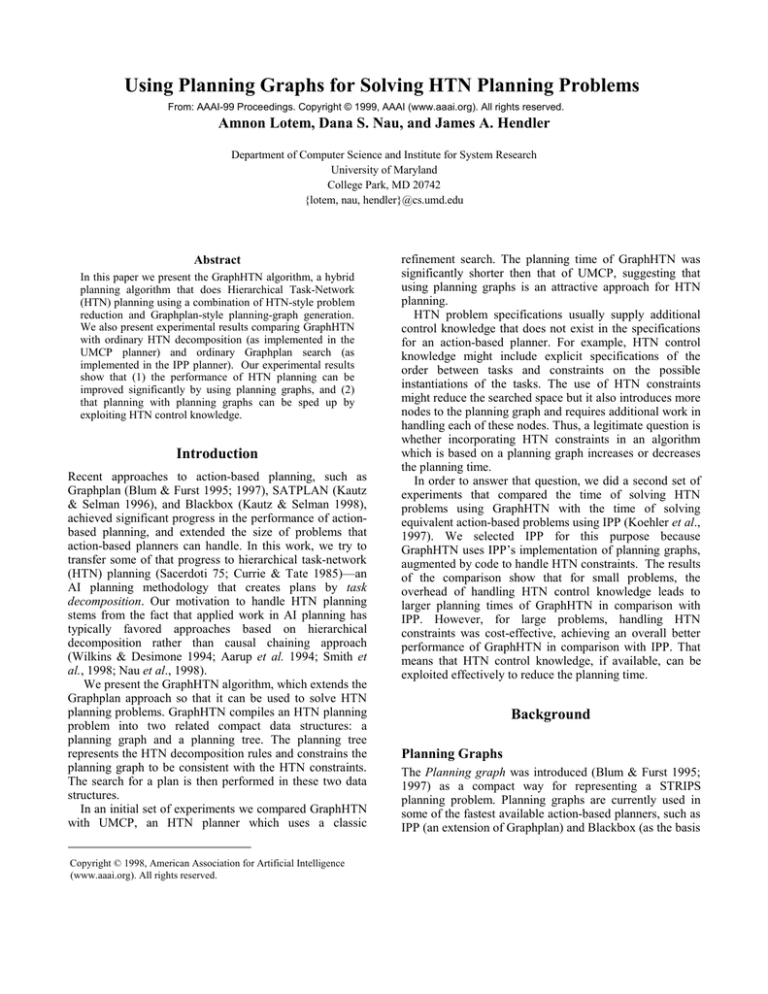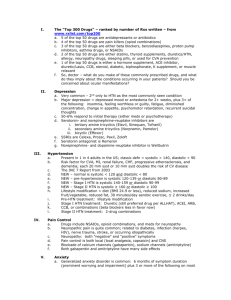Using Planning Graphs for Solving HTN Planning Problems
advertisement

Using Planning Graphs for Solving HTN Planning Problems
From: AAAI-99 Proceedings. Copyright © 1999, AAAI (www.aaai.org). All rights reserved.
Amnon Lotem, Dana S. Nau, and James A. Hendler
Department of Computer Science and Institute for System Research
University of Maryland
College Park, MD 20742
{lotem, nau, hendler}@cs.umd.edu
Abstract
In this paper we present the GraphHTN algorithm, a hybrid
planning algorithm that does Hierarchical Task-Network
(HTN) planning using a combination of HTN-style problem
reduction and Graphplan-style planning-graph generation.
We also present experimental results comparing GraphHTN
with ordinary HTN decomposition (as implemented in the
UMCP planner) and ordinary Graphplan search (as
implemented in the IPP planner). Our experimental results
show that (1) the performance of HTN planning can be
improved significantly by using planning graphs, and (2)
that planning with planning graphs can be sped up by
exploiting HTN control knowledge.
Introduction
Recent approaches to action-based planning, such as
Graphplan (Blum & Furst 1995; 1997), SATPLAN (Kautz
& Selman 1996), and Blackbox (Kautz & Selman 1998),
achieved significant progress in the performance of actionbased planning, and extended the size of problems that
action-based planners can handle. In this work, we try to
transfer some of that progress to hierarchical task-network
(HTN) planning (Sacerdoti 75; Currie & Tate 1985)—an
AI planning methodology that creates plans by task
decomposition. Our motivation to handle HTN planning
stems from the fact that applied work in AI planning has
typically favored approaches based on hierarchical
decomposition rather than causal chaining approach
(Wilkins & Desimone 1994; Aarup et al. 1994; Smith et
al., 1998; Nau et al., 1998).
We present the GraphHTN algorithm, which extends the
Graphplan approach so that it can be used to solve HTN
planning problems. GraphHTN compiles an HTN planning
problem into two related compact data structures: a
planning graph and a planning tree. The planning tree
represents the HTN decomposition rules and constrains the
planning graph to be consistent with the HTN constraints.
The search for a plan is then performed in these two data
structures.
In an initial set of experiments we compared GraphHTN
with UMCP, an HTN planner which uses a classic
Copyright © 1998, American Association for Artificial Intelligence
(www.aaai.org). All rights reserved.
refinement search. The planning time of GraphHTN was
significantly shorter then that of UMCP, suggesting that
using planning graphs is an attractive approach for HTN
planning.
HTN problem specifications usually supply additional
control knowledge that does not exist in the specifications
for an action-based planner. For example, HTN control
knowledge might include explicit specifications of the
order between tasks and constraints on the possible
instantiations of the tasks. The use of HTN constraints
might reduce the searched space but it also introduces more
nodes to the planning graph and requires additional work in
handling each of these nodes. Thus, a legitimate question is
whether incorporating HTN constraints in an algorithm
which is based on a planning graph increases or decreases
the planning time.
In order to answer that question, we did a second set of
experiments that compared the time of solving HTN
problems using GraphHTN with the time of solving
equivalent action-based problems using IPP (Koehler et al.,
1997). We selected IPP for this purpose because
GraphHTN uses IPP’s implementation of planning graphs,
augmented by code to handle HTN constraints. The results
of the comparison show that for small problems, the
overhead of handling HTN control knowledge leads to
larger planning times of GraphHTN in comparison with
IPP. However, for large problems, handling HTN
constraints was cost-effective, achieving an overall better
performance of GraphHTN in comparison with IPP. That
means that HTN control knowledge, if available, can be
exploited effectively to reduce the planning time.
Background
Planning Graphs
The Planning graph was introduced (Blum & Furst 1995;
1997) as a compact way for representing a STRIPS
planning problem. Planning graphs are currently used in
some of the fastest available action-based planners, such as
IPP (an extension of Graphplan) and Blackbox (as the basis
name
by_truck
delivery
moving_truck
packing
specification
transport(?p, ?o, ?d):n1: at-truck(?t, ?o)
n2: ld(?p, ?t, ?o)
n3: at-truck(?t, ?d)
n4: uld(?p, ?t, ?d)
formula:
n1 < n2 and n2 < n3 and
n3 < n4 and ?o ≠d and
between(at-truck(?t, ?o), n1, n2) and
between(at(?p, ?t), n2, n4) and
between(at-truck(?t, ?d), n3, n4)
transport(?p, ?o, ?d):n1: pckd(?p)
n2: dlvr(?p, ?o, ?d)
n3: vrfy(?p, ?d)
formula:
n1 < n2 and n2 < n3 and
initially(small(?p)) and
before(at(?t, ?o), n2 ) and
between(dlvrd(?p, ?d), n2, n3)
and ?o ≠ ?d
at-truck(?t, ?l):n1: mv(?t, ?o, ?l)
formula:
before(not at-truck(?t, ?l), n1) and
before(at-truck(?t, ?o), n1)
pckd(?p):n1: pck(?p)
formula:
before(not pckd(?p), n1)
Table 1: The methods of the simple transportation domain.
for the SAT encoding of a planning problem). A planning
graph contains alternate levels of proposition nodes and
action nodes. An action appears at level i if all its
preconditions appear in the i-th proposition level. A
proposition appears at the first proposition level if it is a
part of the initial state. A proposition appears at level i > 1
if it is an “add” effect of some action in the previous action
level. Graphplan constructs the planning graph level by
level, and searches for a plan in the current graph after each
extension of the graph. During that process the algorithm
identifies, propagates and makes use of certain mutual
exclusion relations among nodes.
Recent works have extended the types of problems that
can be solved using planning graphs beyond problem
described as pure STRIPS-style operators, to problem
descriptions that allow unified quantifiers and conditional
effects (Gazen & Knoblock, 1997; Koehler et al., 1997,
Anderson et al., 1998), simple numeric constraints
(Koehler, 1998) probabilistic operators (Blum and
Langford, 1998), and sensing actions in the face of
uncertainty (Weld et al., 1998).
mv(?t, ?o, ?d)
pre: at-truck(?t, ?o)
post: ~at-truck(?t, ?o),
at-truck(?t, ?d)
pck(?p)
pre: not pckd(?p)
post: pckd(?p)
ld(?p, ?t, ?l)
pre: at(?p, ?l),
at-truck(?t, ?l)
post: ~at(?p, ?l),
at(?p, ?t)
dlvr(?p, ?o, ?d)
pre: at(?p, ?o)
post: ~at(?p, ?o),
dlvrd(?p, ?d)
uld(?p, ?t, ?l)
pre: at(?p, ?t),
at-truck(?t, ?l)
post: ~at(?p, ?t),
at(?p, ?l)
vrfy(?p, ?l)
pre: dlvrd(?p, ?l)
post: ~dlvrd(?p, ?l),
at(?p, ?l)
Table 2: The primitive tasks of the simple transportation domain.
HTN Planning
HTN planning is an AI planning methodology that creates
plans by task decomposition. The planning problem is
specified by an initial task network, which is a collection of
tasks that need to be performed under specified constraints.
The planning process decomposes tasks in the initial task
network into smaller and smaller subtasks until the task
network contains only primitive tasks (operators). The
decomposition of a task into subtasks is performed using a
method from the domain description. The method specifies
how to decompose the task into a set of subtasks. Each
method is associated with various constraints that limit the
applicability of the method to certain conditions and define
the relations between the subtasks of the method. The
following constraints can be associated with a method: an
order constraint between two subtasks n1 and n2 (n1 <
n2), designation and codesignation constraints between
two variables or between a variable and a constant (u = v,
u ≠ v, u = c, u ≠ c) and the following state constraints:
• initially(P(?x)) means that a specified proposition P
should be true in the initial state.
• before(P(?x), n)) means that P should be true before
starting subtask n of the method.
• after(P(?x), n)) means that P should be true after
accomplishing subtask n of the method.
• between(P(?x), n1, n2)) means that P should be true
between subtasks n1 and n2 of the method.
As an example, we will use the simple transportation
domain presented in Tables 1 and 2. In this example, the
transport compound task is responsible for transporting a
package ?p from location ?o to location ?d. It can be
performed by either using a truck or a delivery service. The
by_truck method has four subtasks: having the truck ?t at
?o, loading the package into ?t, having the truck at ?d and
unloading the package. at-truck is a predicate task which is
decomposed into the primitive task mv (move) if the truck
is not yet at the desired location ?l or into do-nothing if the
truck is already at ?l. The subtasks of the method are totally
ordered. Between constraints are used to protect the effects
• The set of constraints associated with tn are satisfiable
and p is consistent with these constraints.
The way GraphHTN finds valid plans will be illustrated
using the simple transportation problem specified in Figure
1.
which are generated by one subtask and are consumed by
another. The delivery method has three subtasks: having
the package packed, delivery, and verification of the
package arrival.
In general, HTN planning is strictly more expressive than
STRIPS-style planning (Erol et al. 1994b). HTN planners
traditionally use classical refinement search for finding a
plan. A recent work showed how an HTN planning
problem can be encoded as a propositional satisfiability
problem (Mali & Kambhampati 98).
Initial task network:
n1: transport(p1, L1, L4)
n2: transport(p2, L2, L4)
Initial state:
small(p1)
small(p2)
at(p1, L1)
at(p2, L2)
at-truck(t1, L3)
GraphHTN
GraphHTN is a novel algorithm for solving HTN planning
problems based on the Graphplan approach. It gets as an
input an initial task network tn0 to be accomplished, an
initial state I, and an HTN domain description D which
specifies the primitive tasks (operators), compound tasks
and the methods which can be used. GraphHTN produces
plans in the Graphplan format: a set of actions and
specified times in which each action is to be carried out.
Several actions may occur at the same time if they do not
interfere with each other.
Unlike Graphplan, GraphHTN has no goals that a valid
plan should achieve. Instead a valid plan should be one
which can be generated from the initial task network. More
precisely, a plan p is valid iff there is a task network tn
such that:
• tn can be generated from the initial task network tn0 by a
sequence of task decompositions and valid instantiation
of variables.
• tn consists of only ground primitive tasks.
• The set of ground primitive tasks in tn is identical to the
set of actions in p.
L3
t1
L4
L1
delivery
A three steps solution:
step 1: mv(t1,L3,L1)
step 2: ld(p1,t1,L1)
step 3: mv(t1,L1,L2)
step 4: ld(p2,t1,L2)
step 5: mv(t1,L2,L4)
step 6: uld(p1,t1,L4),
uld(p2,t1,L4)
step 1: pck(p1)
pck(p2)
step 2: dlvr(p1,L1,L4)
dlvr(p2,L2,L4)
step 3: vrfy(p1,L4)
vrfy(p2,L4)
Figure 1: A simple transportation problem: two packages p1 and
p2 should be transferred to L4 by either using a truck or a delivery
service. Two possible solutions are presented.
The Planning Tree
A planning tree is an And/Or tree that represents the set of
all possible decompositions of the initial task network up to
a certain depth. Planning trees have two kinds of nodes:
task nodes (the “or” nodes) and method nodes (the “and”
nodes). The root of the planning tree is a special method
node that is labeled root. The nodes immediately under the
root represent the tasks in the initial task network. The
P1 C3
AND
P1 C1
Do-nothing
pckd
(p1)
Method
Totallyordered
method
P1
P2 C2 P3 C3
dlvr
vrfy
(p1,L1, (p1,L4)
L4)
P1 C3
AND
OR
delivery
AND
delivery
p2
A six steps solution:
transport(p1,L1,L4)
Primitive
task
p2
L2
root P1 C3
Nonprimitive
task
p1
p1
by
truck
initial task
network
transport(p2,L2,L4)
OR
delivery
AND AND
by
truck
P1 C1
P2 C2 P3 C3
P1 C1
P2 C2 P3 C3 P1 C1
P2 C2 P3 C3
ld at-truck uld
pckd
ld
at-truck
dlr
at-truck
at-truck uld
vrfy
(p2) (p2,L2, (p2,L4) (t1,L2) (p1,t1, (t1,L4) (p2,t1,
(t1,L1) (p1,t1, (t1,L4) (p1,t1,
L1)
L4)
L4)
L2)
L4)
P
P1
P1 C1 1 P1 C2 P1 C1 P1
P3 P3 C3 P3 C3 P3 C3
pck C2 mv
mv
mv
mv
mv
mv
C2
C2
(t1,
(p1)
(t1,
(t1,
(t1,
(t1,
(t1,
L2,L1) L3,Ll) L4,L1)
L1,L4) L2,L4) L3,L4)
P
P
P1 C1 1 P1 C2 P1 C1
P1 3 P3 C3 P3 C3
P3 C3
mv
pck C2
mv
mv
mv
mv
mv
(t1,
(p2)
(t1,
(t1,
(t1,
(t1,
(t1,
L1,L4) L2,L4) L3,L4)
L1,L2) L3,L2) L4,L2)
Figure 2: The planning tree for the simple transportation problems. Nodes which can generate actions for the i-th time step are marked by
PI. Nodes that could be accomplished at time i are marked by Ci.
children of a task node are all the instantiated methods that
can be used for decomposing the task. The children of a
method node are all the subtasks of the method. Figure 2
shows a planning tree for the simple transportation
problem. Right under the root we have the two transport
tasks. Both of them should be carried out in order to solve
the problem. Each transport task can be decomposed using
either the delivery or the by truck method, the at-truck(t1,
L1) task can be decomposed to do-nothing or to mv
operations from various locations, and so forth.
A specific solution for the planning problem corresponds
to a subtree of the planning tree in which each nonprimitive task node has exactly one method node as it
child. For example, the subtree shown in boldface in Figure
2 represents a solution based on the delivery method.
The Planning Graph
GraphHTN uses a similar planning graph to the one used
by Graphplan. The difference is that an action node might
also represent the preconditions of a non-primitive task (as
defined by before or between constraints). Such an action
has no add or delete effects. Its appearance in the graph
indicates that the corresponding task can start at that level.
A Description of the Algorithm
GraphHTN builds the planning tree and the planning
graph synchronically and uses both of them in the search
process. GraphHTN is sound and complete (Lotem and
Nau 1999). However, as the HTN planning is semidecidable (Erol 1994b), the termination of the planning
process when no solution exists is not guaranteed. When no
recursive method exists, the planner is guaranteed to report
the shortest plan if a plan exists, and to halt if there is no
solution.
An outline of the algorithm appears in Figure 3.
GraphHTN starts with a planning tree consisting of the
tasks in the initial task network, and a planning graph that
has a single proposition level describing the initial state.
Like Graphplan, the algorithm runs in stages. In each stage
it appends to the planning graph one action level and one
proposition level and searches backward for a plan in the
extended graph. The HTN constraints are introduced by
using the planning tree which guides both processes.
Extending the planning graph. Rather than using every
applicable action for extending the graph, GraphHTN only
uses actions that can be generated for the current time step
by decomposing recursively the initial task network. That
keeps the graph consistent with the HTN constraints (a
similar idea was used (Barrett and Weld 1994) in extending
UCPOP to handle tasks decomposition). Technically, this
is done by extending first the prefix of the planning tree:
expanding recursively the planning tree by decomposing
each task t in the tree which holds the following conditions:
• Every task ti that is ordered before t (i.e. ti < t) has
already marked as could be accomplished in a previous
Algorithm GraphHTN(tn0, I, D)
Input: An initial task network tn0, an initial state I, and
an HTN domain description D.
Output: a valid plan or “Failure”.
Data Structures: A planning tree T and a planning graph G.
Initially, G is empty and T has a single node: root.
Insert each p ∈ I into the first action level of G.
Insert each t ∈ tn0 as a child of T’s root.
for i := 1 to max-length
extend the prefix of the planning tree T;
extend the planning graph G;
if the root of the tree could be accomplished then
search for plan p of length i;
if solution was found then return “Success, plan is ”, p;
end;
end;
return “Failure”.
Figure 3: an outline of the GraphHTN algorithm.
time step (tasks are marked as could be accomplished as
part of extending the planning graph).
• All the preconditions of t (i.e., before and between
constraints of t) are satisfied at the current proposition
level.
The expansion of a task t is done by generating a child
node for representing every applicable instantiation of t’s
methods. The instantiation of a method takes in account the
current binding of free variables and the designation,
codesignation and initially constraints of the method. For
each new method node the algorithm creates the
corresponding subtask nodes and continues to expand
these new nodes recursively only if they hold the above
conditions. The Pi label in Figure 2 indicates that the
corresponding node was part of the prefix of the tree at
time-step i.
The new actions that are created while extending the
prefix of the tree are added to the active set of actions.
Only actions from the active set are used (if applicable) to
extend the planning graph. Including an action that
represents a primitive task at level i of the graph means that
the action could be accomplished in that time step. We
extend that notion to methods and non-primitive tasks:
• A method could be accomplished at level i if all its
subtasks could be accomplished at level i or earlier.
• A non-primitive task could be accomplished at level i if
at least one of its methods could be accomplished at
level i or earlier.
When an action is added to the planning graph the could be
accomplished property is propagated upward in the tree.
The Ci label in figure 2 indicates that the corresponding
node was first marked as could be accomplished in step i of
the algorithm.
The Search. In Graphplan a search is performed only if the
last proposition level includes all the goals. In an HTN
planning problem there are no goals to be achieved.
Instead, all the tasks in the initial task network should be
accomplished. Therefore, the search starts when the root of
the tree is marked as could be accomplished. Methods that
could not be accomplished within the current number of
time steps are filtered out of the planning tree and the
planing graph (in the example: the two instances of the
by_truck method are ignored by the search for a plan of
length three). The search uses a level-by-level approach
going backward from the last level of the planning graph
toward its first level. However, in order to get a solution
which is consistent with the HTN constraints, the search is
guided top-down by the planning tree. This is done as
follows:
• For each level i of the planning graph the algorithm
selects the set of tasks to be accomplished at level i
before proceeding to level i - 1. The algorithm does not
decide at that point at which levels the selected tasks
start.
• For each non-primitive task t that is selected to be
accomplished at level i of the graph, the algorithm also
selects a method for performing t. This is a backtracking
point.
• The algorithm can select a task t to be accomplished at
level i of the graph (i.e., t is selectable) only if:
1) t is a subtask of a selected method m.
2) Every other subtask ti of m that is ordered after t (t <
ti) starts after time i.
3) t is not mutual exclusive to any other task that has
already been selected for level i.
4) t does not delete any goals required for level i+1.
• The decision whether to select a selectable task t for the
current level or to postpone its selection for a level
smaller than i is also a backtracking point.
• Selecting a primitive task sets the start time of that task
and possibly the start time of non-primitive tasks which
are ancestors of t. The preconditions of the tasks that
start at the i-th level of the graph, together with the open
goals from levels greater than i, define the required goals
for level i–1.
In the case of no recursive methods, the algorithm halts
when a plan is found or when the length of the planning
graph exceeds the maximum number of planning steps that
can be generated by the planning tree. When the domain
includes recursive methods, an iterative deepening
approach is used in order to preserve the completeness of
the algorithm. In the k-th deepening iteration, expansions
are constrained to at most k recursion levels. If no solution
was found in iteration k, the limit of the recursion level is
increased by a predefined constant and the whole process
repeats1.
Due to space considerations, we will only mention here
some of the additional extensions made to the algorithm to
accommodate the requirements of HTN planning:
• mutual exclusiveness – eliminating mutex relations
between an action and its ancestors;
• memoization – the set of tasks that can be selected for
level i-1 is also recorded in the memoized configuration
(in addition to the current set of goals);
• handling the do-nothing task;
• handling after and between constraints.
The implementation of GraphHTN consists of two major
components: the HTN component, which is responsible for
building and searching the planning tree, and the planning
graph component. The planning graph component was
adopted with some modifications from the IPP planner
(Koehler et al., 1997).
Experiments
Methodology
We evaluated the performance of GraphHTN by comparing
it against UMCP (Erol 1994a), an HTN planner which uses
a classic refinement search. We used two types of
transportation problems. In problem 1, n packages in n
different locations should be transferred to a common
destination using a single truck. In problem 2 the packages
should be transferred to n different destinations.
We used the same set of problems to assess the
contribution of HTN control knowledge to the performance
of the planner. We compared the time of solving the HTN
problems using GraphHTN with the time of solving
equivalent action-based problems using IPP (Koehler et al.,
1997). We chose IPP for that purpose because GraphHTN
uses IPP’s implementation of planning graphs, augmented
by code to handle HTN constraints.
Results
The running time and the number of search nodes explored
by each planner are presented in Table 3. The times were
measured on Sun Ultra with 143 MHZ clock and 64 MB
RAM. Figures 3 and 4 present the running times
graphically using a logarithmic scale for the time.
The comparison between GraphHTN and UMCP is not
absolutely fair, as UMCP is written in lisp and GraphHTN
is written in C and C++. However, the performance
difference between the planners is so great that re-coding
UMCP in C would probably not make a big difference. We
also present in Table 3 the number of search nodes
explored by GraphHTN and UMCP. However, this
comparison is somewhat misleading, since creating a new
node in UMCP requires duplication of the whole task
1
We are currently examining an alternative approach in which the
bound on the recursion level is dynamically deducted from the
current length of the graph. As the length increases, nodes might
be added to earlier levels of the graph. That excludes the need for
iterations on the recursion level and assures the optimality of the
extracted plan in terms of the number of time steps.
Prob # of Plan Total Elapsed Time
lem pack- length Graph UMCP IPP
ages
HTN
2
6
0.10
1.2 0.04
1
3
8
0.26 81.1 0.09
2
# of Search Nodes
Graph
UMCP
IPP
HTN
94
65
47
2541
2219
1092
4
5
10
12
1.89 > 1 h
20.29 > 1 h
0.64 3.9 * 104
25.84 4.8 * 105
>
6
7
14
16
192 > 1 h
2012 > 1 h
1501 5.2 * 106
> 1h 4.9 * 107
2
3
8
12
0.14
0.53
1.7
327
0.07
0.31
4
5
16
20
3.27
20.22
>1h
>1h
14.19 4.7 * 104
1731 3.3 * 105
_
6
7
24
28
118
1419
>1h
> 1h
> 1h 2.0 * 106
> 1h 1.0 * 207
-
-
-
-
2 * 104 3.8 * 104
1.7 * 106
8.6 * 107
-
278
4883
-
107
7754
133
104
106
108
-
Table 3 – The total elapsed time (in seconds) and the number of
searched nodes for GraphHTN, UMCP and IPP.
F
H
V
H
2012
1500
H
O
D
F
P V
L
W
F
L
G
H P
V K
W
S L
U
D
D
O
H J
O
R
D O
W
R
7
192
81
25.84
20.29
1.89
1.2
0.26
*UDS+71
80&3
,33
0.64
0.1
0.09
0.04
RISDFNDJHV
Figure 3: Total elapsed times for problem 1.
1731
F
H
V
G
H
V
S
D
O
H
O
D
W
R
7
1419
OH
D
H F
V
P
L
W
LF
P
K
LW
U
D
J
R
O
327
118
20.22
14.19
1.7
3.27
0.53
*UDS+71
80&3
,33
0.31
0.14
0.07
control knowledge led to larger planning times (using
GraphHTN) than planning without it (using IPP). However,
for large problems (more than 4 packages) handling HTN
control knowledge was cost-effective, and led to shorter
planning times than planning without it. The numbers of
search nodes present a similar picture.
RISDFNDJHV
Figure 4: Total elapsed times for problem 2.
network, which involves much computation and memory.
The failure of UMCP to solve the problems for more than
three packages is basically due to its high consumption of
memory.
The comparison with IPP shows that for small problems
(up to 4 packages) the overhead of handling the HTN
Discussion and Conclusions
We have presented GraphHTN—an HTN planner which
compiles an HTN planning problem into a planning graph
and a planning tree, and searches in this combined data
structure for a plan. In our experiments, GraphHTN solved
HTN planning problems significantly faster then UMCP. In
addition, GraphHTN found plans that are optimal in terms
of the number of time steps (this is not necessarily true for
the plans found by UMCP). The primary reason for
GraphHTN’s fast performance relative to UMCP is
somewhat similar to the reason for Graphplan’s fast
performance relative to UCPOP:
• The planning graph makes properties like reachability
from the initial state and mutual exclusiveness explicitly
available to the search phase, reducing significantly the
amount of search needed.
• When failures occur for the same reason in different
parts of a search space, the memoization reduces the
amount of time spent in searching those different parts of
the search space.
In addition, GraphHTN searches within a single (but
complex) data structure, while UMCP maintains and
explores hundreds of candidate task networks in its search
process and thus exhausts the available memory quite fast.
We also tried to assess the value of the HTN control
knowledge for reducing the planning time. There are two
competing factors here:
• On one hand, there is an overhead in handling the HTN
constraints: additional nodes should be introduced into
the planning graph to represent preconditions of
compound tasks and more time is spent in selecting a
node for the solution in order to assure its consistency
with the planning tree.
• On the other hand, even a small amount of HTN control
knowledge might reduce the size of the searched space.
For example, the transport method states that each
package is loaded once and that this is done in the initial
location of the package. In the action-based version of
the problem this constraint is missing and the
construction phase of the planning graph introduces for
each package “load” actions that load the package at
every possible location. As a result, the backward search
spends extra time in eliminating these alternatives—time
that is not needed in the GraphHTN algorithm.
In our experiments, for big enough problems, handling the
HTN control knowledge was cost-effective and led to
smaller planning times. We actually used in these
experiments very limited amount of additional control
knowledge—for example, we did not use GraphHTN's
methods and operators as a vehicle for writing domain-
specific planning algorithms, as has been done in some
other HTN planners (Nau et al., 1999). We believe that if
we had made more control knowledge available to
GraphHTN, its planning performance would have been
even better.
For the future, we plan to compare GraphHTN and
UMCP on a wider set of problems. We also plan to explore
more systematically the value of different levels of HTN
control knowledge on the performance of GraphHTN.
We intend to examine the role of propagating different
HTN properties through the planning tree in limiting the
search space and investigate alternative search strategies.
Another research direction is to replace GraphHTN’s
current search strategy by a process that encodes the
planning graph and the planning tree as a propositional
satisfiability problem and then uses a SAT solver for
performing the search (similar to the way it is done in
Blackbox for action-based planning problems).
Acknowledgments
We thank Jana Koehler for the permission to embed the
code of IPP within GraphHTN. This research was
supported in part by the following grants and contracts:
Army Research Laboratory DAAL01-97-K0135, Naval
Research Laboratory N00173981G007, Air Force Research
Laboratory F306029910013, and NSF DMI-9713718.
References
Anderson, C.; Smith, D.; Weld, D. 1998. Conditional
effects in Graphplan. In Proc. AIPS-98, 44-53.
Aarup, M. and Arentoft, M. and Parrod, Y. and Stader, J.
and Stokes, I. 1994. OPTIMUM-AIV: A knowledge based
planning and scheduling system for spacecraft AIV.
Intelligent Scheduling, Morgan Kaufmann, Fox M. and
Zweben M., 451-469.
Barrett, A. and Weld, D. 1994. Task decomposition via
plan parsing. In Proc. AAAI-94, 1117-1122.
Blum, A. and Furst, M. 1995. Fast planning through
planning graph analysis. In Proc.14th Int. Joint Conf. AI,
1636-1642.
Blum, A. and Furst, M. 1997. Fast planning through
planning graph analysis. J. Artificial Intelligence, 90(1–
2):281–300.
Blum, A. and Langford, C. 1998. Probabilistic planning in
the Graphplan Framework. Working notes of the
Workshop on Planning as Combinatorial Search held in
conjunction with AIPS-98, Pittsburgh, PA, 1998, 8-12.
Currie, K. and Tate, A. 1985. O-Plan - control in the open
planning architecture. BSC Expert Systems Conference,
Cambridge University Press.
Erol, K.; Hendler, J.; and Nau, D. 1994a. UMCP: a sound
and complete procedure for Hierarchical Task-Network
planning, In Proc. AIPS-94, 249-254.
Erol, K.; Nau, D.; Hendler, J. 1994b. HTN planning:
complexity and expressivity. Proc. AAAI-94.
Gazen, C. and Knoblock, C. 1997. Combining the
expressivity of UCPOP with the efficiency of Graphplan.
In Proc. ECP-97, Toulouse, France, 1997.
Kambhampati, S.; Knoblock, C.; and Yang, Q. 1995.
Planning as refinement search: a unified framework for
evaluating design tradeoffs in partial order planning.
Artificial Intelligence, 76(1-2):167-238.
Kautz, H. and Selman, B. 1996. Pushing the envelope:
Planning prepositional logic, and stochastic search. In
Proc. AAAI-96, Portland, OR. 1996.
Kautz, H. and Selman, B. 1998. Blackbox: A new
approach to the application of theorem proving to problem
solving. Working notes of the Workshop on Planning as
Combinatorial Search held in conjunction with AIPS-98,
Pittsburgh, PA, 1998, 58-60.
Koehler, J. ; Nebel, B.; Hoffman, J; and Dimopoulus Y.
1997. Extending planning graphs to an ADL subset. In
Proc. ECP-97, Toulouse, France, 1997.
Koehler, J. 1998. The IPP planner: exploring the
possibilities of planning graphs. Working notes of the
Workshop on Planning as Combinatorial Search held in
conjunction with AIPS-98, Pittsburgh, PA, 1998, 71-74.
Lotem, A. and Nau., D. 1999. The Soundness and
Completeness of GraphHTN. Working Paper.
Mali, A.; and Kambhampati, S. 1998. Encoding HTN
planning in propositional logic. In Proc. AIPS-98, 190198.
Nau, D.; Smith, S. J.; and Erol, K. 1998. Control Strategies
in HTN Planning: Theory versus Practice. AAAI-98/IAAI98, 1127–1133.
Nau, D.; Cao, Y.; Lotem, A.; and Muñoz-Avila, H. 1999.
SHOP: Simple Hierarchical Ordered Planner. IJCAI-99.
Sacerdoti, E. 1975. The nonlinear nature of plans. In Proc.
IJCAI-75, 206-214.
Smith, S. J.; Nau, D.; and Throop, T. 1998. Computer
bridge: a big win for AI planning. AI Magazine 19(2), 93–
105.
Weld, D; Anderson, C; Smith, D. 1998. Extending
Graphplan to handle uncertainty & sensing actions. In
Proc. AAAI-98, 897-904.
Wilkins, D. and Desimone R. 1994. Applying an AI
planner to military operations. Intelligent Scheduling,
Morgan Kaufmann, M. Fox and M. Zweben, 685-709.





